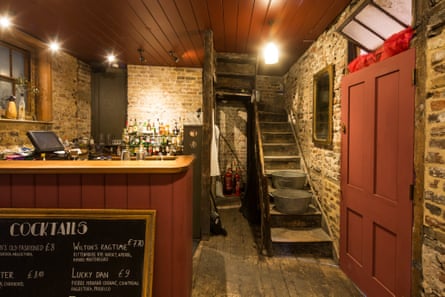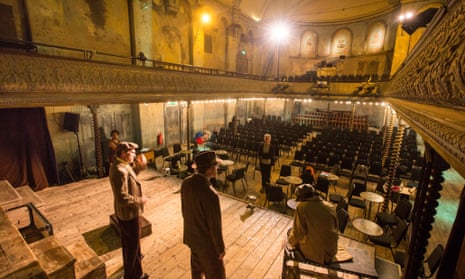As the East End’s border with the City of London becomes choked with towers of luxury flats, it might come as a surprise to find that just streets away from billboards trumpeting “off-plan investment opportunities” clings an institution that thrives on its decrepitude. After a £4m restoration project, the oldest pub music hall in the world is looking as ramshackle as ever.
“We didn’t want to lose the atmosphere of it being a forgotten old wreck,” says Tim Ronalds, the architect who has been working on Wilton’s Music Hall since 2006, leading an intricate process of keyhole surgery and shoring up you might never know had happened. “It shouldn’t have a National Trust preciousness – it’s a rough, tough, working place whose character comes from wear and tear.”
Wilton’s is one of east London’s best-kept secrets – a beguiling Tardis of crumbling Victoriana hidden behind a row of unassuming terraces, tucked down a back street in Whitechapel. Like stepping through the wardrobe into Narnia, visitors head to the back of a tumbledown pub and walk through a small passage into a vast, barrel-vaulted music hall. A raised stage stands at one end, framed by a triumphal proscenium arch, while an ornate balcony encircles the room, raised on spiralling barley sugar columns – a level originally designated for “unescorted ladies”, safely elevated from the antics below. Encrusted with peeling paint and flaking mouldings, it feels like happening upon a forgotten secret, a room untouched since its 19th-century heyday.
“It’s where variety entertainment began,” says artistic director Frances Mayhew, who has spearheaded the revival of the derelict pleasure palace since 2004, when the Wilton’s Music Hall Trust took over the building. “Through places like this you can chart the development of the professional performer, from people singing in pubs, to cabaret, right up to The X Factor.”

Built by John Wilton in 1859, the “Magnificent New Music Hall” was the third (and by far the grandest) room at the back of the pub for singing, dancing and bawdy revelry, designed to entertain local merchants, dock workers and the thousands of sailors who came to the port of London from all over the world. A renowned den of abandon, it is said to have been better known on the waterfront of San Francisco than St Paul’s Cathedral.
“It was never a quaint, sugary old-time music hall,” says Ronalds. “It was quite a tough place.” A drunken heckler in the crowd was once beaten to death by an enraged actor. He was sent to prison for just two weeks, the victim deemed to have got his comeuppance. It all came to an end following a fire in the 1870s, after which the building was taken over as a Methodist Mission – a move heralded as the triumph of good over the iniquitous temptations of vice, regarded as the root of poverty in the East End.
It is something of a miracle that the building has survived intact since then. It became a rag warehouse in the 1950s and was scheduled for demolition as part of a slum clearance project in the 1960s, until a campaign led by John Betjeman saw it grade II* listed in 1971. The following decades saw the complex subject to various preservation attempts, but they were often left unfinished, usually doing more harm than good.
But it’s these layers of alterations and mutilations over the centuries that give the current Wilton’s its charm. The restoration work, primarily funded by the Heritage Lottery Fund and the Sita landfill trust, has been guided by a principle, says Ronalds, that “we wouldn’t do anything that wasn’t absolutely necessary”. Their rule even extended to keeping an old bird’s nest found in a gap in a wall, along with broken fireplaces, rotten window frames and fragments of pipe from the old gas lighting.

The result is a fascinating place to explore: a labyrinthine world of colliding half-levels, ancient staircases leading nowhere and ruined walls giving glimpses through to disused rooftops and floors below. One room is criss-crossed by exposed timber framing, long since stripped of its lath and plaster walls, while another offers a view down into the hidden backyard world between the terraced houses and the gnarled old wall of the music hall, now lit by a subtle new roof-light.
Into this precarious carcass (which is held up in places by old railway tracks and dollops of plaster) the architects have somehow managed to thread all the servicing and infrastructure a modern-day theatre needs, along with new rehearsal space, dressing rooms, an archive, offices, prop-making workshop and a new kitchen, opening up 40% of the complex that was previously off-limits. It is a kind of invisible mending, where it’s impossible to tell what is new and what is old.
“We didn’t want to do anything too ‘architecty’, making a play of the contrast between new and old,” says Ronalds, who has previously worked subtle magic on other East End bastions the Hackney Empire and the Ironmonger Row Baths. But Wilton’s is unlike any other project, with a lot of work going on behind the scenes to meet fire regulations and other modern standards, while retaining the effortless patina of decay.
“Now that we don’t have to fear for the fabric of the building any more, we can really focus on the artistic programme, from theatre to dance to opera to classical music to puppetry to family shows, with more popular performances sitting alongside more experimental works, nurturing artists at the start of their careers,” says Mayhew. Open to the public throughout the building work, Wilton’s relaunches this week, promising to bring back some of the rumbustious life of the Victorian institution – hopefully minus the murderous performers.

Comments (…)
Sign in or create your Guardian account to join the discussion